Infra
New York City-area Rail Agencies See Major Work Ahead

The New York City Metropolitan Transportation Authority on Sept. 18 finally provided some clarity on its next five-year transit spend plan through 2029, with details in limbo for that and for 2020 to 2024 spending because of the “indefinite pause” in June by New York Gov. Kathy Hochul of a congestion pricing program that was set to provide key funding.
Acknowledging the “elephant in the room,” two days earlier at at the ENR NY/NJ Infrastructure Forum in Manhattan, Jamie Torres-Springer, president of MTA Construction & Development, told attendees the agency was taking the governor “at her word” that about $15 billion set for the current five years “will be restored in due time,” whether through congestion pricing or “some other means.”
The agency announced that over its next five years, the $68.4-billion spend includes $65.4 billion in system investments it will submit Oct. 1 to the Capital Program Review Board for approval, and $3 billion for bridges and tunnel investments.
“The great thing about the MTA and the way that we’ve been set up over the last 40 years is by law we have to work in five-year capital programs,” Torres-Springer said. “While there are sometimes pauses and reconsideration and things like that, and it is challenging to figure out how to fund each successive program, we are by law always moving forward.”
Structural repairs will be a major focus of the 2025-29 MTA plan, due Oct. 1 to the Capital Program Review Board, The agency weighed different benchmarks assessing investment needed, including its own 20-year needs assessment and reviews by investment bank JP Morgan, the state comptroller and the Citizens Budget Commission.
“We feel very confident about being able to award very high magnitudes of work,” Torres-Springer said, citing $11.4 billion in contract awards in 2022 and expecting similar annual levels in the next plan. “That’s our new normal,” he added, acknowledging that litigation against congestion pricing reduced 2023 awards by $2 billion.
“We feel very good about what we’ve achieved at construction and development as an owner of preference for industry,” he added. “We’re getting good bids. We’re getting competitive design-build procurements. Torres-Springer said MTA will continue its trend of bundling projects into single contracts for cost and space efficiencies.
Work on “structures and power” will be emphasized in the next plan, with the Grand Central Artery in Manhattan also set to receive attention, including a tunnel that leads into the rail station having “serious life safety and structural issues.” Across the subway system, 65 miles of elevated rack and hundreds of miles of underground track are in “poor and marginal condition,” said Torres-Springer.
The MTA climate resilience strategy will address “six billion dollars of needs over the next 10 years and we intend to make a major down payment on those in this next five-year plan,” which will focus on “high-priority” risks.
Other efforts will address outfitting bus depots, shops and yard for an all-electric bus fleet by 2040 and ADA accessibility work, with 95% of subway stations to be revamped under a $7.1-billion outlay. That will bring overall system accessibility to 50%
Amtrak: Making Up For Lost Time
US rail carrier has aggressive infrastructure program planned over the next several years, fueled by $66 billion in federal IIJA funding
Chart courtesy of Amtrak
With rail delays on its key Northeast Corridor line growing, “years of underinvestment [are] showing every day and that is not acceptable,” said Jay Sankar, Amtrak vice president of infrastructure delivery, as he updated details of the U.S. passenger rail carrier’s push to take on long delayed large infrastructure projects now made possible by $66 billion in new federal infrastructure law funding—one-third earmarked for its heavily traveled Northeast Corridor.
“We are now an operator of inner-city passenger service, and we’re also a builder, something Amtrak has really never done before,” he said.
According to Sankar, Amtrak has hired about 8,000 employees in the last three years to boost a staff depleted during the COVID-19 pandemic, and with engineering, construction and owner experience with large project management. He said the carrier is set to award $15 billion in contracts by year end, with about 700 current projects in its portfolio valued at $200 million or more, compared to “only a handful or two” at that size in 2019.
“These are projects that have been on the drawing board … for decades,” Sankar noted. “This version of [infrastructure law funding] is a down payment on the amount of infrastructure money that we need.”
But Sankar cautioned that large project work must proceed with limited or no track closure, and more interaction with multiple rail line users. “There is nothing Amtrak can do on its own,” he said, noting a new internal team dedicated to manage track access coordination and force account resources. The effort worked successfully on recent Pennsylvania line work, compressing project completion from two years to eight months, and saving $30 million, Sankar said, although adding that the access effort is still “a work in progress.”
Procurement also continues since last November on a major Amtrak effort, in coordination with NJ Transit, to replace Sawtooth Bridges—an early 20th century corridor link in Kearney, N.J., that connects multiple lines and carries more than 400 trains daily. The project received $132.3 million in federal funding to support early construction. When complete, its new four-track replacement structure will double current capacity. Sankar said a construction management-at-risk contract award is planned, due to the complex project logistics, which he termed a “site access and coordination nightmare.”
Sankar also noted Amtrak plans to expand Penn Station but did not confirm design or procurement details.
Displaying a detailed slide of Amtrak project procurements and an array of alternative project delivery approaches anticipated, Sankar noted that if he had shown the same visual five years ago, all “would say design-bid-build.”
A “look ahead” at upcoming procurement will be posted on Amtrak’s website likely next month, he said.
Amtrak capital delivery “is two and a half years old, so we are still building, we are still learning and we are still looking for … support of … this industry to help us deliver on the plan,” Sankar told attendees.
‘Breathtaking’ NJ Work Pace
Rich Shaefer, senior vice president of capital programs for New Jersey Transit, gave an update of work on the Portal Bridge rail project and of the agency’s overall capital plan, noting that “for a relatively small agency, we pulled in almost a billion dollars of federal money in fiscal 2023.” Related to the bridge, “we’re looking at October of 2027 to start seeing track laid out with trains running on it,” he said. “It’s hard to grasp just how big this structure is; it is almost three miles of work. In many ways, it’s a wall job that happens to have a bridge in the middle.”
Shaefer said construction is averaging $60 million a month, “so you’re talking about invoicing $2 million every single day. We’ve had months where we’re up to $5 million a day, which is breathtaking.”
The agency is looking into battery-electric locomotives with “potential to eliminate our use of diesel on our entire system,” he noted. “We have a zero-emissions bus study, which we’re advancing as well.” A bus garage modernization, new bus terminals and renovated train stations are also in the works, including at New York Penn Station and in New Jersey.
NJ Transit has 20+ construction and design opportunities on the books, Shaefer said, noting “about $6 billion of work here that we’re putting out into the design and construction community. It is my goal that next year, every single month, there will be a ribbon cutting or a shovel on the ground for groundbreaking in the state of New Jersey. It will be a banner year for transit and for the state.”
Jim Morrison, senior technical advisor for the Gateway Development Commission, gave a program update on the construction of planned new Hudson River tunnels. “In the last year, we have established our full funding grant,” he said. “When I was here a year ago, the [commission] was about 30 people. Now we’re around 150 people.”
As for construction, “they’re doing ground improvement right now in the river that will facilitate tunnel work … and to clear obstructions.”
The Tonnelle Avenue bridge and utility relocation project in New Jersey is well under construction, Morrison said. “That’s a relatively small project, but is really the linchpin to this program. All of our other contracts feed in through Tonnelle Avenue. “It’s the access point for mining … and for tunnel muck disposal. It’s really key.”
The $465.6-million contract awarded last month for the New Jersey-side tunnels will not be the last big award, he added. “The next several will likely be bigger than that.”
One tunnel from the Hudson County Hoboken line under the river to 12th Avenue, “will be a lot more complex and will likely be a lot more expensive,” Morrison said. “On the planning side, we’re deep into looking at the systems that will go into this tunnel and make it operate—the rail, the electric, the signals, the fire life safety systems and the ventilation.”










